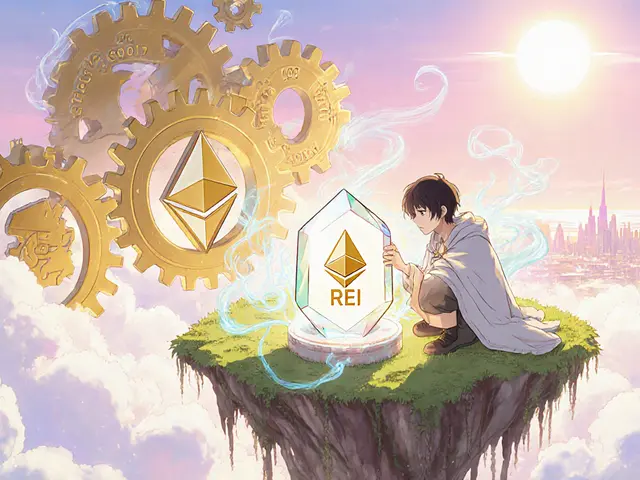1
How Blockchain Transforms Patent Management in 2025

Blockchain Patent Management Impact Calculator
Estimated Benefits of Blockchain Implementation
Time Savings
0
days saved annually
Cost Reduction
$0
annual savings
Automation Efficiency
0%
process automation
Comparison Metrics
| Metric | Traditional System | Blockchain System |
|---|---|---|
| Time to Record | Weeks-Months | Minutes |
| Proof of Creation | Paper certificates | Immutable timestamped hash |
| Ownership Traceability | Fragmented databases | Unified shared ledger |
| Licensing Cost | Manual contracts | Smart contracts |
| Security | Central server attacks | Cryptographic consensus |
Implementation Recommendation
Based on your inputs, blockchain implementation could provide significant improvements:
- Time Savings: days saved annually
- Cost Reduction: in annual legal fees
- Automation: process automation
Consider starting with a Proof-of-Concept in a single jurisdiction before full rollout.
Key Takeaways
- Blockchain creates immutable timestamps that prove inventorship instantly.
- Smart contracts automate licensing and royalty payments without middlemen.
- Global standards like SIP and LHF are emerging to bridge national patent systems.
- Legal eligibility under US 35U.S.C.§101 remains the biggest hurdle.
- Adopting a phased implementation roadmap reduces risk and speeds ROI.
Patent owners, IP lawyers, and tech startups are all asking the same question: can the hype around blockchain patent management actually solve the paperwork nightmare of today’s IP world? The answer is a qualified yes. By the end of this guide you’ll know what blockchain brings to the table, how to wire it up, and which pitfalls to dodge.
Understanding the Core Technologies
Before diving into use cases, let’s clear up the building blocks.
Blockchain is a decentralized ledger that records transactions across a network of computers, making every entry tamper‑evident. Each block stores a cryptographic hash that points to the previous block, forming an unbreakable chain.
Cryptographic Hash is a fixed‑size string generated from any data, uniquely representing that data without revealing its content. In patent management the hash acts as a digital fingerprint of an invention’s description.
Smart Contract is a self‑executing code stored on a blockchain that triggers actions when predefined conditions are met. Think of it as a programmable legal clause that can transfer royalties the second a product ships.
Why Traditional Patent Systems Fall Short
Conventional IP offices rely on centralized databases, paper filings, and manual clerical checks. The process suffers from three chronic issues:
- Delay: Registration can take months, sometimes years, especially for cross‑border filings.
- Opacity: Ownership transfers and licensing histories are scattered across jurisdictions, making audit trails fuzzy.
- Cost: Lawyers, translation fees, and maintenance fees pile up quickly.
These pain points become acute for fast‑moving sectors like AI, IoT, and finance where a month‑long lag can mean a missed market window.
How Blockchain Improves Patent Management
When you overlay blockchain on top of the existing IP workflow, four game‑changing capabilities emerge:
- Immutability: A hash‑based timestamp proves an invention existed at a specific moment, admissible in many jurisdictions as electronic evidence.
- Transparency: Every transfer of ownership or license is recorded on a shared ledger, creating a single source of truth for auditors.
- Automation: Smart contracts enforce licensing terms, calculate royalties, and release payments without human intervention.
- Decentralized Governance: No single office controls the data, reducing reliance on costly intermediaries.
Real‑world data supports the trend: the European Patent Office saw a 220% rise in blockchain‑related filings between 2015 and 2018, and by 2025 more than 12% of all AI‑oriented patents reference a blockchain component.

Architectural Blueprint
Implementing a blockchain‑based patent system involves several layers. Below is a simplified stack, each layer annotated with its primary function.
| Layer | Purpose | Key Technologies |
|---|---|---|
| Data Ingestion | Capture filing documents, generate hashes | IPFS, SHA‑256 |
| Ledger Core | Store hashes, timestamps, ownership records | Ethereum, Hyperledger Fabric |
| Smart‑Contract Engine | Automate licensing, royalty splits | Solidity, Chaincode |
| Interoperability Layer | Bridge with national patent offices | SIP (Standardization and Interoperability Protocol) |
| Legal‑Tech Interface | Translate blockchain events into legally recognised evidence | LHF (Legal Harmonization and Framework Integration) |
| Presentation UI | Dashboard for inventors, attorneys, examiners | React, Web3.js |
Benefits Over Traditional Systems
Below is a side‑by‑side look at how the two approaches compare on the metrics that matter most to patent stakeholders.
| Metric | Traditional | Blockchain‑Based |
|---|---|---|
| Time to Record | Weeks-Months | Minutes (hash + transaction) |
| Proof of Creation | Paper certificates, not always admissible | Immutable timestamped hash |
| Ownership Traceability | Fragmented national databases | Unified ledger visible to all parties |
| Licensing Cost | Manual contracts, high legal fees | Smart contracts, near‑zero execution fee |
| Security | Central server attacks | Cryptographic consensus, tamper‑evident |
Challenges & Legal Hurdles
It’s not all smooth sailing. Several obstacles still need addressing:
- Eligibility under US law: The Berkeley Technology Law Journal (2022) highlighted that many blockchain‑related inventions struggle to satisfy 35U.S.C.§101, leading to higher rejection rates.
- Interoperability: Existing national databases were not built for distributed ledgers, so the SIP effort is still in pilot mode in Europe and Asia.
- Data Privacy: GDPR‑compliant designs must hide personal data while keeping the ledger transparent-a delicate balance.
- Evidence Acceptance: Courts in some jurisdictions still question whether a blockchain timestamp is admissible proof.
Legal experts such as Anne Rose of Mishcon de Reya stress the need for “legal‑tech interfaces” (the LHF component) that translate blockchain events into formats recognized by courts.
Implementation Roadmap: From Pilot to Production
Adopting blockchain for patents is a multi‑phase journey. Follow these steps to reduce risk:
- Stakeholder Alignment: Get buy‑in from inventors, legal counsel, and IT. Define clear KPIs - e.g., 30% reduction in filing time.
- Proof‑of‑Concept (PoC): Choose a single jurisdiction (e.g., UK) and a narrow technology area (AI‑related algorithms). Record a handful of hashes on a public testnet.
- Integrate SIP: Work with national IP offices to map their data fields to the blockchain schema.
- Deploy LHF Layer: Build middleware that converts blockchain events into legally‑recognised certificates.
- Scale Smart Contracts: Automate standard licensing clauses. Test royalty distribution with sandbox payments.
- Governance Model: Establish a consortium (e.g., PatentChain Alliance) to manage protocol upgrades and dispute resolution.
- Full Rollout: Expand to cross‑border filings, onboarding IoT and fintech firms.
Typical PoC budgets range from $150k to $300k, with ROI realized within 12‑18 months once automation cuts legal fees by 40‑60%.
Future Outlook: 2025 and Beyond
By the end of 2025, three trends will shape the landscape:
- Global Standard Adoption: The WIPO‑backed SIP is expected to be ratified by the major patent offices, creating a universal ledger schema.
- AI‑Powered Examination: Blockchain‑anchored data will feed machine‑learning models that predict novelty and prior art, shortening examiner workloads.
- Cross‑Tech Convergence: As IoT devices embed their own patents, on‑device smart contracts will auto‑license usage rights in real time.
Companies that lock in a blockchain‑ready IP strategy now will enjoy faster market entry, tighter control over royalties, and a solid defensive moat against infringement.

Frequently Asked Questions
Can a blockchain hash replace a traditional patent certificate?
A hash provides immutable proof of existence, but most jurisdictions still require a formal certificate for enforceability. The hash can supplement the certificate and, in some pilot programs, act as the primary evidence.
Which blockchain platforms are best suited for patent management?
Permissioned networks like Hyperledger Fabric offer privacy controls needed for confidential inventions, while public chains such as Ethereum give broader transparency. Many consortia adopt a hybrid model: private side‑chains for data and a public anchor for timestamps.
How do smart contracts handle royalty splits for multiple stakeholders?
A smart contract can store a mapping of beneficiary addresses and percentage shares. When a licensing event is triggered, the contract automatically calculates each share and initiates on‑chain transfers, eliminating manual calculations.
What legal steps are needed to make blockchain evidence admissible?
Jurisdictions are drafting guidelines that require a cryptographic hash, a trusted timestamp authority, and a clear audit trail linking the hash to the original filing. Engaging a qualified legal‑tech consultant to produce a compliant evidence report is essential.
Is the technology scalable for thousands of patents per year?
Yes, modern blockchains support tens of thousands of transactions per second on layer‑2 solutions. The main bottleneck is integration with legacy IP office databases, not the chain itself.









Mark Camden
December 1, 2024 AT 05:10When the integrity of intellectual property is at stake, the adoption of immutable ledgers becomes a moral imperative. The legal community must recognize that decentralization does not diminish responsibility; it merely redistributes it to a transparent framework. Consequently, any entity that ignores this shift is complicit in perpetuating inefficiency and fraud.
Evie View
December 1, 2024 AT 05:43Your sanctimonious rant sidesteps the gritty reality that many firms lack the resources to overhaul legacy systems. Cutting through bureaucracy with a blockchain is not a noble quest; it is a cold‑blooded cost‑cutting maneuver that will leave small innovators scrambling.
Jason Brittin
December 1, 2024 AT 06:16Yo, the whole "minutes versus weeks" hype feels like a meme, but honestly, it’s kinda cool to see patents getting a crypto makeover. 😎 If you’re not on board yet, you’re probably still stuck in the 90s.
Amie Wilensky
December 1, 2024 AT 06:50Indeed, the contrast between "minutes" and "weeks‑months" is stark; however, one must also consider the latency introduced by consensus algorithms, the cryptographic overhead, and the regulatory ambiguities that accompany such a transition.
MD Razu
December 1, 2024 AT 07:23Blockchain technology, by virtue of its distributed ledger architecture, offers a paradigm shift that reshapes the conventional contours of patent administration. First, the immutable timestamped hash provides incontrovertible proof of creation, eradicating the longstanding disputes over priority dates. Second, the decentralized nature eliminates single points of failure, thereby enhancing security against cyber‑attacks that plague centralized repositories. Third, smart contracts automate licensing agreements, translating legal obligations into machine‑executed code that reduces administrative overhead. Fourth, the unified ledger ensures traceability of ownership, facilitating seamless transfer of rights across jurisdictions. Fifth, the consensus mechanism enforces transparency, rendering any clandestine modifications virtually impossible. Moreover, the reduction in filing time-from weeks to minutes-accelerates innovation cycles, allowing inventors to focus on research rather than paperwork. Cost‑efficiency emerges not merely from reduced legal fees but also from minimizing the need for intermediaries such as patent attorneys and filing agents. The integration of cryptographic signatures guarantees authenticity, while the open‑source nature of many blockchain platforms fosters collaborative enhancements. Nonetheless, challenges persist, including scalability constraints, regulatory compliance, and the steep learning curve associated with blockchain adoption. Addressing these obstacles requires a phased implementation strategy, commencing with pilot projects in innovation‑friendly jurisdictions. By aligning stakeholder incentives through tokenized reward structures, the ecosystem can incentivize participation and data integrity. Finally, the cultural shift towards embracing decentralized governance heralds a new era where intellectual property is not only protected but also democratized, empowering creators worldwide.
Charles Banks Jr.
December 1, 2024 AT 07:56Sure, a 1‑line pitch sounds snazzy, but reality will bite you when the network slows down.
Ben Dwyer
December 1, 2024 AT 08:30There’s a lot of potential here, and anyone can start small-just focus on a single process and iterate. Consistency beats flashiness every time.
Lindsay Miller
December 1, 2024 AT 09:03Keep it simple: start with filing timestamps and watch the savings grow. You’ll thank yourself later.
Katrinka Scribner
December 1, 2024 AT 09:36Loving the idea of patents on the blockchain! 😍 It’s like giving inventions a digital passport. Can't wait to see it in action.
VICKIE MALBRUE
December 1, 2024 AT 10:10Exciting stuff ahead.
Waynne Kilian
December 1, 2024 AT 10:43i think it could really democratize invenntion, but we need to be careful about accesbility.
Naomi Snelling
December 1, 2024 AT 11:16They don’t tell you that the whole system is a front for a global data siphon. Trust no one.
Michael Wilkinson
December 1, 2024 AT 11:50Enough of the sugar‑coating-if you can’t secure your own data, you’re dead in the water.
Billy Krzemien
December 1, 2024 AT 12:23Implementing a blockchain pilot can be a low‑risk way to test the waters. Start with a single department, gather metrics, and scale based on results.
april harper
December 1, 2024 AT 12:56While the allure of immutable ledgers is undeniable, one must ponder whether the very act of recording every nuance of invention could stifle creativity, turning the patent office into a digital mausoleum where ideas lie dormant, awaiting validation.
Clint Barnett
December 1, 2024 AT 13:30Think of the blockchain as a collaborative canvas, where every brushstroke is recorded and celebrated. By integrating smart contracts, you empower inventors to license their work instantly, turning bureaucracy into a vibrant marketplace. This isn’t just tech; it’s a cultural renaissance for creators, blending transparency with empowerment. When you layer cryptographic security over a shared ledger, you foster trust that transcends borders, allowing innovators from Nairobi to New York to co‑develop without fear of appropriation. The beauty lies in the community‑driven governance-stakeholders vote on upgrades, ensuring the system evolves with its users. Such an ecosystem encourages diversity of thought, as barriers to entry dissolve; small startups can now compete with conglomerates on equal footing. Moreover, the data richness of on‑chain records fuels analytics, revealing trends in invention that were previously invisible. This intelligence can guide policy, investment, and education, creating a feedback loop that propels society forward. While challenges remain-scalability, regulatory alignment, user adoption-these are solvable puzzles, not insurmountable walls. By approaching the transition incrementally, piloting in niche sectors, and iterating based on feedback, we can craft a resilient, inclusive framework. Ultimately, blockchain’s promise in patent management is not just efficiency; it’s democratization, turning the patent landscape into an open, vibrant garden where ideas flourish.
Jacob Anderson
December 1, 2024 AT 14:03Nice pep talk, but in reality most firms will just slap a token on top and call it a day.
Kate Nicholls
December 1, 2024 AT 14:36The idea of a transparent ledger is appealing, yet the industry must tread carefully to avoid overpromising.
Carl Robertson
December 1, 2024 AT 15:10Oh, sure, because the patent world has never been plagued by drama before. Bring on the blockchain, let’s see if it can handle the inevitable infighting.
Rajini N
December 1, 2024 AT 15:43From a practical standpoint, integrating blockchain with existing filing software can be done via APIs. Start by mapping data fields, then test the hash generation for each submission. This approach minimizes disruption while showcasing the tech’s benefits.
Prince Chaudhary
December 1, 2024 AT 16:16Great point-keep the integration lightweight, and let the team see quick wins. Momentum builds confidence.
John Kinh
December 1, 2024 AT 16:50Another hype train, lol 🙄. I bet the ROI will be as elusive as the promised “decentralized utopia”.
Kate Roberge
December 1, 2024 AT 17:23Honestly, these buzzwords just mask the fact that most legal departments are afraid of change. Get over it.
Oreoluwa Towoju
December 1, 2024 AT 17:56I'm curious how this could empower inventors in emerging markets. If the tech is truly open, it could level the playing field.
Sidharth Praveen
December 1, 2024 AT 18:30Exactly! With the right guidance, anyone can tap into this tech and accelerate their ideas. Let’s keep the optimism alive.